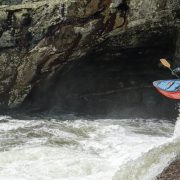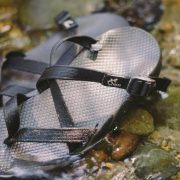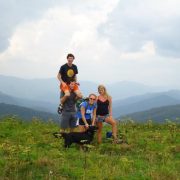Southern author Eugene F. Walter once wrote, “summer in the deep South is not only a season, a climate, it’s a dimension. Floating in it, one must be either proud or submerged.” Perhaps this explains why the waters here are so well-explored and appreciated by paddlers from all over the United States. Despite the fact that proud locals would likely prefer their rivers uncrowded, the word is out: the South has epic rivers.
The rivers and creeks of this region have a very distinctive character. Most of the waterways originate from the Southernmost reaches of the old Appalachian Mountains and plateaus, moving towards the east or the west with rushing speed. Starting off as small streams beneath a canopy of lush deciduous forests, round boulders and well-worn bedrock shape their rapids and hidden waterfalls. They join together and course through gorges, until the gradient subsides as they drop closer to sea level, flattening their waters and encouraging a variety of paddle sports.
With so many options, mild year-round temperatures, and generous annual rainfall, the South is a coveted destination for paddlers of all abilities and passions. In this guide, we’ll work our way through the absolute best Southern rivers for paddling, from beginner to expert level.
The Easiest: Flatwater to Beginner Whitewater (Class I-II+)
1.Chipola River, Florida
Starting down in Florida, a novice paddler can find many opportunities to explore freshwater springs and riverside caves while viewing swamp wildlife and historical artifacts. The enchanting Chipola River in Western Florida is a great way to see the best of what the area has to offer. As part of the Dead Lakes State Recreation Area, there are two sections: the 51-mile Chipola River Designated Paddling Trail and the 4.5-mile Upper Chipola River Designated Paddling Trail, separated where the river disappears underground. Fed by 63 springs, the Chipola has a set of small rapids and is also home to the unique shoal bass.
2. Wateree River Blue Trail, North and South Carolina
Weaving 75 miles through the Carolina countryside, the Wateree River Blue Trail has several sections of gentle rapids and flatwater that are both accessible and worthy of interest. Draining a natural wooded floodplain, the waterway is a haven for wildlife such as bald eagles, otters, and kingfishers. This river basin is one of the few precious places that remain in the Southeast where populations of white shoals spider-lily thrive in decent numbers.
3. Hiwassee River Blueway, Tennessee
Heading West to Tennessee’s Hiwassee River Blueway** **gives you the option to step up to class II if desired. The upper section of the river in the mountains of the Cherokee National Forest is where you’ll find these rapids, and while they appear steep, they are not overwhelmingly difficult. Once you get past the town of Reliance, the river mellows, and floating peacefully past the trees can be a serene experience. The cool water flows year round, downstream of the TVA Apalachia powerhouse.
4. Nantahala River, North Carolina
The Nantahala Gorge is nestled between the North Carolina mountains just outside Bryson City. The walls are so steep here that the sunlight can only make it to the valley floor at high noon, hence the name Nantahala, which is Cherokee for “land of the noonday sun.” At the bottom of the gorge, you’ll find eight miles of mostly class II (+) rapids, with a finale of the class III Nantahala Falls, an optional portage. Cold, reliable water flows year round from a nearby powerhouse, making this a very popular and accessible river.
5. Clear Creek, Tennessee
From a solid perch high on the Cumberland Plateau, the upper stretches of Clear Creek meander downhill through numerous shoals and class II rapids that require precise maneuvering. Adventurous, overnight paddlers will pass caves and unique rock formations along the 20-mile waterway before encountering a class III rapid towards the end. Portage is certainly an easy option for those who aren’t up for the challenge.
The In-Between: Intermediate to Advanced (Class III-IV)
6. Obed Wild and Scenic River, Tennessee
Following Clear Creek downstream will eventually lead to the unspoiled, rugged terrain of the Obed Wild and Scenic River near Wartburg, Tennessee. The longest free-flowing, roadless river in Tennessee looks mostly the same today as it did to settlers in the 1700s. The bottom 10 miles from Obed Junction to Nemo are cradled between 500-foot tall canyon walls and are full of class II-III, with some light class IV rapids. Both the Obed and Clear Creek are remote and will be flowing mostly in the winter and spring, so be sure to dress accordingly.
7. Big South Fork, Tennessee
The northeastern edge of the Cumberland Plateau opens up to the towering cliffs and massive boulders of the Big South Fork, yet another remote Tennessee classic. In the vicinity of O’Neida, this river is the centerpiece of a national recreation area, with class III & IV rapids that significantly step up in difficulty with rising water levels. The waters here are elusive to summer, so cold weather gear is again required.
8. Chattooga River, Georgia
Known as the filming site of the movie Deliverance, the Chattooga River is located near the Georgia town of Clayton, near the Georgia/South Carolina border. Whether paddling the Narrows (class III) or the Five Falls (class IV), the Chattooga is a Deep South Appalachian wilderness classic with year-round water. Summer on the Chattooga is a welcome introduction to running tight lines and slots with precision, a pool/drop contrast to the fluffy, continuous higher flows of winter and spring. Beware of the dangerous siphons that exist within the pot-hole strewn rocks native to this wild and scenic river.
9. Tellico River, Tennessee
The place where the Cherokee once gathered in great numbers is known today as the Tellico River. Just off the Cherohala Skyway in southeastern Tennessee, a small, paved road to a trout hatchery follows the river closely and offers easy access to the scattered waterfalls (from 5-14 feet tall) and continuous rapids along the way. After any decent rainfall, the Tellico will be teeming with paddlers boofing (and plopping) their way down the class III and IV drops. It’s by far the most popular and appropriate place to run a waterfall for the first time.
Getting Tougher: Advanced to Expert (Class IV-V)
10. Watauga River, North Carolina
Most of the solid class IV rapids and drops of the Watauga River lie in North Carolina, but the class V Stateline Falls marks the border of Tennessee. While once regarded as some of the most difficult whitewater in the South, the Watauga remains a classic due to the quality of it’s distinctive rapids. For five glorious miles, paddlers will boof and punch their way downstream, finding clean vertical lines and honing their skills to move forward in creek boating expertise.
11. Little River Canyon, Alabama
You might not expect to find a massive canyon in the corner of Alabama, yet high atop Lookout Mountain near Fort Payne is exactly what skilled paddlers descend into the depths of. At Little River Canyon, the put in is aesthetically marked with a wide cascade of 33 feet, most commonly run on the left, where it is divided into two tiers. It is also common to put in below, where the river begins a complicated route through boulder sieves and sluices known as the ‘Suicide Section.’ The scenery from the bottom is top-notch as Little River gains the volume of many side creeks that appear suddenly from both steep sides.
12. Tallulah Gorge, Georgia
The mighty Tallulah Gorge in Georgia was dry for a very long time before, in the 1990s, Georgia Power began releasing water every spring and fall from the upstream dam. Packing a big punch of 20 class IV-V rapids and no less than six waterfalls in a single mile, the Tallulah’s signature drop is a monster slide called Oceana. Set within an impressive gorge with limited access, the put in requires descending almost 600 steps with your boat while viewing (and bypassing) several large unrunnable waterfalls. Taking out requires paddling across Lake Tugaloo.
For Extreme Experts Only (Class V+)
13. Raven Fork, North Carolina
Once quietly hidden at the southern tip of the Smoky Mountains on the border of the Cherokee Reservation, a little stream called the Raven Fork demands attention. This creek, within its notorious gorge, yields no forgiveness to the ambitious experts who penetrate and plunge the numerous steep descending drops. Rapid names like ‘Mike Tyson’s Punchout’ should clarify this point. Dropping nearly 600 feet per mile, it’s a scary, mysterious place for paddling for most, but for the experienced paddlers out there, it’s a challenging favorite destination when the rain hits.
14. Bear Creek, Georgia
Among the very best of Chattanooga’s steep creek offerings is the dramatic Bear Creek of Cloudland Canyon. ‘The Hair of the Bear’ flings itself from atop Lookout Mountain in Georgia, over many tall, distinctive bedrock drops—the most remarkable being a 50-foot, three-tiered hit called ‘Stairway to Heaven’. Towards the bottom, after merging with Daniel Creek, the ‘Boulder Garden’ begins it’s relentless and powerful tumble to the take out. Eddies and scouting are possible, but the best lines through this maze are behind those who already know the way. Being good enough to run this means you’ll be in the loop when it rains hard enough.
15. Horsepasture and Toxaway Rivers, North Carolina
The finale of this list is shared by the breathtaking Horsepasture and Toxaway Rivers, which could be called the Southern cousins of the Sierra Nevada. The incessant, plummeting gradient of the California-esque Toxaway is unmatched by any other Southern river, while the Horsepasture follows closely behind it. Both rivers are equally inviting, with a sizable picturesque drop starting off the day.
Toxaway is characterized by clean lines over fast slides cradled in smooth bedrock, while Horsepasture is all about linking clean waterfalls in succession. On both of these streams, there are sizable drops that result in nerve-wracking moments. In addition to maximizing the limits of runnable whitewater, paddlers must expect strenuous hike out access, persistent scouting on sketchy terrain, and steep portage routes. For a dose of adventure with quality paddling that demands fitness, experience, and confident class V skills, these rivers are the best practice platform for whitewater expedition paddling in more remote areas around the globe.
Originally written by RootsRated for Outdoor Sports Marketing.
Featured image provided by Angela Greenwell













